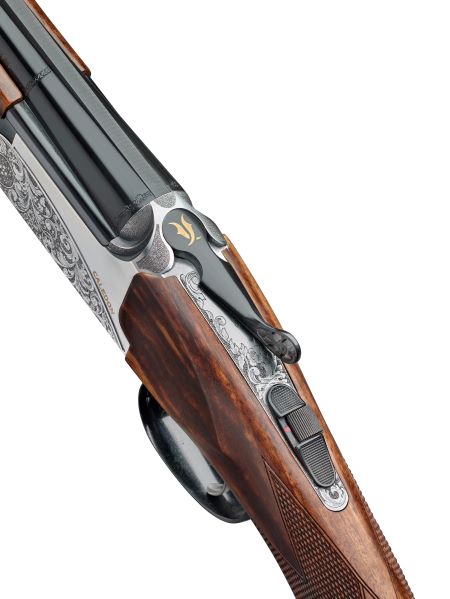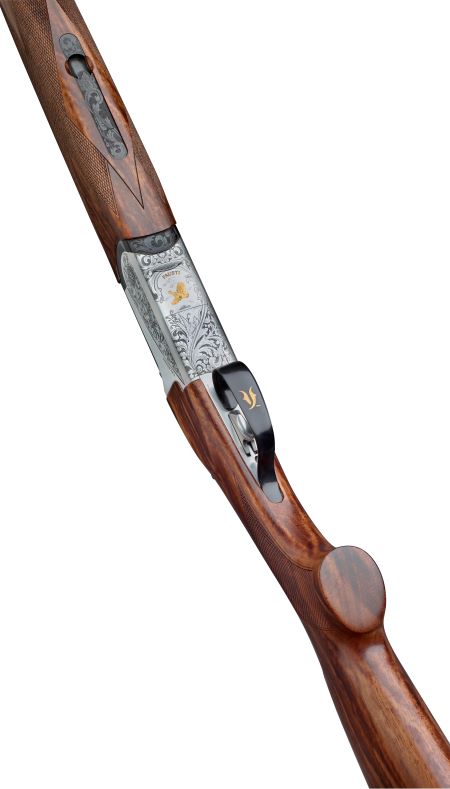The Affordable Fausti Caledon Shoots Above Its Class
At a suggested retail price of around $2,500 for the 12 and 20 gauge, the Fausti Caledon is the tip of the spear of affordable shotguns in the company’s Core Line – important for expanding the Italian gunmaker’s share in the American wing and clays market. With some new aesthetic tweaks to the established Caledon, it appears that Fausti’s design team nailed the original Caledon value proposition of an entry-level over/under that continues to be rugged, attractive and accomplished. After shooting the latest Fausti Caledon, it’s easy to walk away with the impression of handling a price-class leader that delivers on functionality and durability, but now with a splash more glitz.

The all-steel Caledon is built like a bank vault and should probably last for generations (talk about making memories). Fausti’s patented Four Locks System works as advertised. Its four lugs machined into the receiver ensure vertical and horizontal lock-up against the hardest kicking ammunition that might be used on ducks, geese and high-flying driven birds. Concurrently, the lock-up integrity between the barrels and receiver also helps maintains accuracy throughout the life of the shotgun. The receiver is machined from a single forged steel billet. The Caledon is available in five gauges from 12 to .410 (including 16), with proportionally scaled receivers up to 28 gauge that promise enhanced aesthetics and handling. For the 28 gauge and .410 the prices start at around $3,200.

Caledon owners and fans will notice two visual upgrades to the current model. Called Optiwood, the walnut grain has been laser-enhanced with robust checkering for an above-grade appearance. The black trigger guard, meanwhile, features the new Fausti logo. Bold laser acanthus scroll engraving was bordered within a shape similar to the famed Nike swoosh along the lower part of the receiver, with the upper section a contrasting plain bright finish. A gold bird adorned the bottom of the receiver. The tight wood-to-metal fit belied the shotgun’s price point. In terms of parts tolerances, the Caledon assembled and opened easily – a feature I’ll attribute to Fausti’s state-of-the-art factory in Italy.
The Caledon I shot on sporting clays was a 12 gauge with 28-inch barrels topped by a vented rib. The shotgun ships with five standard flush chokes of cylinder, improved cylinder, modified, improved modified and full. With 28-inch barrels, it was clearly a field gun with a steel front bead, no center bead. There was a pistol grip. The automatic safety button and barrel selector were on the top strap, accompanied by a skeletal top lever.

Something about the shotgun made it feel very comfortable and maneuverable. The pistol-grip radius measured six inches and the length of pull 14¾ inches. The field-style forend felt like it provided a solid degree of control from the lead hand. Put it all together and the Caledon was a lovely shotgun to shoot.
However, the 6¾ pounds trigger pull, although somewhat heavy, fell within the parameters of field-gun safety, and after a box of shells became completely manageable. To it’s credit, the inertia trigger was crisp and virtually free of creep.

The Caledon weighed 7¼ pounds, which may contribute to fatigue trekking across public lands in pursuit of wild birds. That said, though, if a 12 gauge coming in at 7¼ pounds causes discomfort under those conditions you’re probably better suited to a 20 or 28 gauge anyway.
Some folks may think it’s overkill, but my standard clays load is 1⅛ ounce with a velocity ranging from 1150 to 1200 feet per second (depending on retail inventory). There was no felt recoil to the shoulder and a bit of sting to the cheek shooting those loads in a Caledon. A one-ounce shell should be quite nice.

Fausti’s Caledon shot flat, which is a personal preference. The shotgun’s balance point, a tad ahead of the hinge pin, helped the shotgun swing smoothly and evenly to maintain target-line integrity. By the second box of shells, I was smoking targets. The shotgun had instilled enough confidence to build effective timing on report and true pairs, as the sight picture facilitated a quick study in target acquisition.
In the end, I couldn’t help but feel that for the money, the Caledon was too good for beginner shooters who likely couldn’t appreciate the value/performance quotient formulated by Fausti for its entry-level over/under. But if you’re a wild bird hunter and can deal with carrying around a 7¼ pound shotgun, the Caledon is one of those worry-free 12 gauges ideal for the field.
Irwin Greenstein is the publisher of Shotgun Life. You can reach him at contact@shotgunlife.com.
Helpful resources:

Irwin Greenstein is Publisher of Shotgun Life. Please send your comments to letters@shotgunlife.com.


Comments